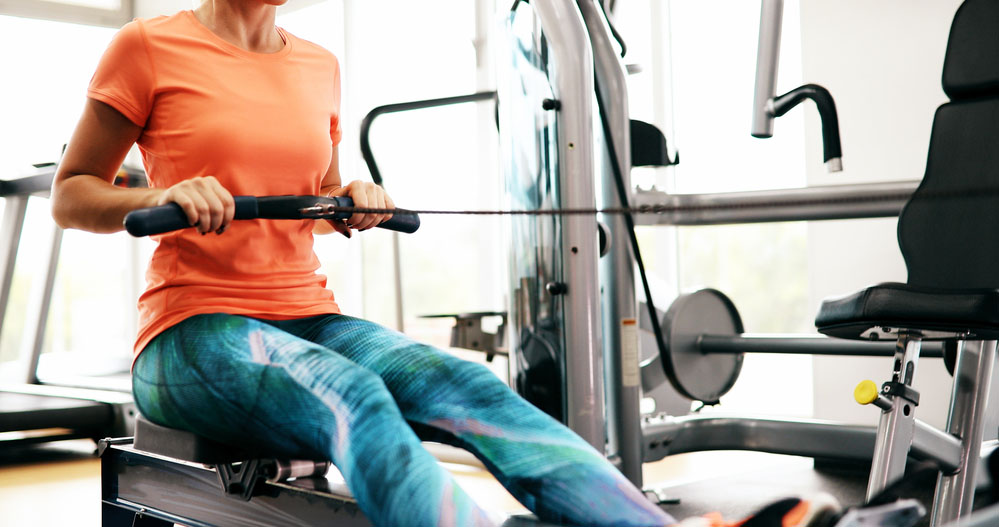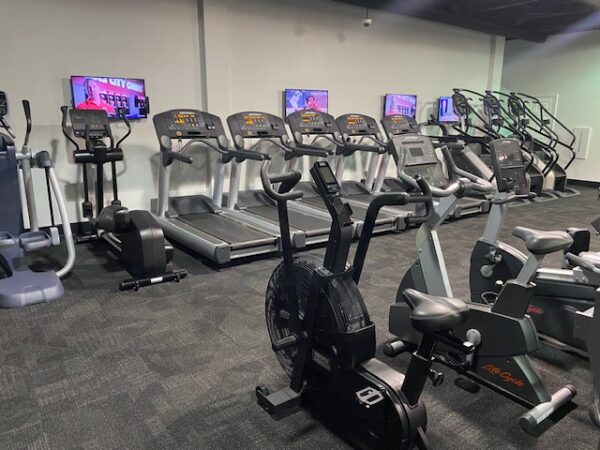Georgia Personal Training/Roswell Fitness Factory
As a fitness aficionado, the journey to a healthier lifestyle is often a quest for workouts that provide the most efficient and enjoyable means of getting fit. In the bustling world of fitness, Rowing Machine Workouts stand as a hidden gem, ready to uncover the full potential of your body’s capabilities. The Roswell Fitness Factory offers high tech Rowing Machines, and our Georgia Personal Training staff will teach proper technique. This comprehensive guide will not only introduce you to the world of rowing but also delve into the unique benefits it offers, from full-body conditioning and cardiovascular health to strength-building and everything in between. Whether you’re a seasoned pro or just setting out on your fitness odyssey, this article is your roadmap to mastering the art of rowing machine workouts.
Rowing machines have been a staple of fitness centers for decades, often overlooked in favor of treadmills and stationary bikes. However, what they lack in the spotlight, they make up for in functionality and effectiveness. A rowing machine, also known as an ergometer (or erg), mimics the action of rowing a boat, combining a forward and backward leg and arm movement with the resistance of water, air, or magnets to create a full-body workout that’s hard to match.
The Silent Hero of the Gym
At first glance, rowing machines may seem intimidating, but their silent, low-impact operation offers a friendly approach to exercise. Unlike their noisier counterparts, the quiet whir of a rower can be a soothing soundtrack to an intense workout.
Full-Body Fitness in One Smooth Motion
One of the rowing machine’s most impressive features is its ability to engage multiple muscle groups simultaneously. Each stroke targets your back, arms, core, and legs, providing a comprehensive workout in every session.
The Multitude of Benefits
The rewards of incorporating a rowing machine into your fitness regime are as vast as the ocean you’re virtually paddling across. Let’s explore the myriad benefits that await those who take to the erg.
- Building Resilience and Staying Injury-Free – Rowing is a renowned low-impact exercise, which significantly reduces the strain on your joints, making it an ideal choice for those recovering from injury or for anyone who values longevity in their fitness journey.
- Heart Health: Row Your Way to a Stronger Cardiovascular System – Rowing is a form of cardiovascular conditioning that can strengthen your heart and lungs, increasing your endurance and enhancing your overall cardiovascular health.
- Strength Training: A Welcome Challenge for Muscles – As a form of resistance training, rowing helps in building and toning muscles. In particular, it targets muscles in your back, shoulders, arms, and legs, offering a strength and endurance building experience.
Mastering the Basics: How to Begin Your Rowing Odyssey
Before you begin to row, it is vital to become acquainted with the basics. Just as you would not set sail without learning the ropes, you should not start rowing without a proper introduction to technique and form.
- The Art of the Stroke: Understanding Rowing Technique – A successful rowing session is built on mastering the proper form. This includes a strong leg drive, a fluid body motion, a controlled arm action, and a precise recovery.
- Setting Your Course: The Importance of Resistance and Intensity – Adjusting the resistance on your rowing machine is akin to setting the difficulty level on the journey of fitness. It can be a balancing act to find the level that challenges you yet allows for a full, strong stroke.
- Navigating Your Warm-Up and Cool-Down – Whether your goal is general fitness or preparation for a specific sport, every great workout should begin with a warm-up and conclude with a cool-down. These rituals prepare your body for the intensity to come and help it recover gracefully afterward.
Launching into Your Rowing Routine: A Guide for Beginners
For those just embarking on their rowing adventure, it’s important to start slowly. Beginning with a few simple sessions will ease you into the rhythm and allow your body to acclimate to the new activity.
- Oar in the Water: Your First Strokes as a Beginner – Focus on fluidity and rhythm rather than speed. Engage your entire body in each stroke and pay attention to the sensation of pulling and pushing against the machine’s resistance.
- Making Waves: Gradually Increasing the Intensity – As you grow more comfortable with the rowing motion, begin to increase the resistance levels and the length of your workouts. Progress should be steady, not rushed, to minimize the risk of overtraining or burnout.
- Intervals and Variations: Spicing Up Your New Routine – Incorporate simple interval training, where you switch between high and low intensities, to add depth to your workouts. Alternating between power strokes and recovery periods can enhance both your strength and endurance.
Rowing’s Intermediate Toolkit: Pushing Beyond the Basics
Once you have become familiar with the machine, and basic techniques, it is time to add sophistication to your routine. Intermediate workouts can provide a new level of difficulties and excitement.
- Riding the Waves of High-Intensity Interval Training (HIIT) – HIIT on a rowing machine involves short bursts of intense rowing followed by brief periods of rest or light paddle. This can dramatically increase your cardiovascular fitness and can be more time-efficient than longer, steady-state workouts.
- Tabata Training: 20 Seconds of Fury – Adopt the Tabata methodology, featuring 20-second bursts of all-out rowing followed by 10 seconds of rest, to enhance both aerobic and anaerobic capacities. This high-paced routine can maintain your body’s caloric burn post-workout for an extended duration.
- The Marathon Quest: Building Endurance Like an Olympian – For the endurance-driven, aim for longer, sustained rowing sessions at a consistent pace. These longer rows can build mental toughness and train your body to perform over extended periods, much like a competitive rower.
Flexibility on the Water: Rowing as a Cross-Training Staple
The beauty of rowing is its versatility. It can serve as a standalone workout or be incorporated into a broader fitness program to complement other exercises and enhance overall performance.
- Super setting: The Dynamic Duo of Rowing and Strength – Pairing a rowing session with strength training can be a potent combination. Alternate between a set of a strength exercise and a rowing set to keep your heart rate up and maximize your time in the gym.
- Circuit Training: A Nautical Twist on a Classic Discipline – Include a rowing interval in a circuit training workout to diversify and intensify your routine. Rowing between traditional strength and cardiovascular exercises ensures a full-body engagement and an efficient use of time.
- Cross-Training on Land and Water: Keeping it Varied and Challenging – Just as cross-training with other sports can improve your overall fitness, integrating rowing with activities like running, cycling, or swimming can provide a well-rounded exercise regimen that targets different muscle groups and energy systems.
The Professional Rower’s Wisdom: Avoiding Common Pitfalls
Every fitness journey is fraught with potential missteps, and rowing is no exception. Here are some common mistakes to look out for, along with strategies to keep your workouts on course.
- Posture and Technique: The Backbone of Successful Rowing – Maintain a strong, straight back throughout your rowing sessions to prevent injury and ensure that your power is transferred efficiently to the machine. A slouched or twisted posture can not only lead to back pain but also diminish the effectiveness of your workout.
- Overtraining and Injury Prevention: Listening to Your Body’s Wake-Up Calls – Rowing may be low-impact, but overtraining is a risk with any intense exercise. Pay attention to any signs of strain or fatigue, and don’t be afraid to take a day off or switch to a different form of exercise if needed.
- Common Injuries and How to Steer Clear – Injuries such as lower back pain, shoulder strains, or blisters are not uncommon among rowers. Educate yourself on proper rowing form, invest in good equipment, and do not hesitate to consult a trainer to avoid these potential hazards.
Plotting Your Course: Setting and Sailing Towards Your Fitness Goals
No voyage is complete without a destination. When it comes to fitness, setting and tracking your goals is an essential component of success. Let’s chart a course together and determine the markers to watch out for on your rowing journey.
- Monitoring Mechanisms: Tools to Gauge Your Progress – Most modern rowing machines come equipped with performance monitors that track distance, time, and even your heart rate. These tools are invaluable for measuring your progress and setting new goals.
- Short-Term Islands and Long-Term Continents: The Importance of Goal-Setting – Start with short-term goals, such as increasing your workout time by five minutes, then set your sights on more ambitious long-term achievements, like participating in a rowing competition or hitting a personal distance or calorie-burning target.
- Buddy System and Community Connection: Sharing the Adventure – Joining a rowing class or finding a workout buddy can provide motivation and accountability. Shared experiences can also make the journey more enjoyable and the victories sweeter.
Concluding Your Rowing Journey
As we conclude our guide to Rowing Machine Workouts, the message is clear: rowing offers a broad spectrum of physical benefits and can be tailored to individuals at every level of fitness. It is a machine with the potential to redefine what home or gym workouts can be — challenging and stimulating, yet gentle on the body. Embrace the rowing machine as your trusty vessel, and let it take you on a voyage towards enhanced health and vibrancy.
Please contact Georgia Personal Training today and let us help you get started or enhance your journey to better fitness!
Join us At Georgia Personal Training!
1) CONTACT US
Give us a call today or submit a contact request through our website. Let us know who you are, what specific services you are interested in, and how we can best contact you. We guarantee a same day response. However, exact response time may vary from day to day based on training sessions.
2) SET UP YOUR INITIAL CONSULTATION
Upon connecting, we will get you scheduled for your initial consultation and free training session. Consultations are a great opportunity for goal setting, discussing strategies, learning the science behind what we do, and uncovering any prior injuries or health issues we should be aware of.
3) COMPLETE YOUR FREE ONE HOUR TRAINING SESSION
The only way to truly understand how good we are, and how much these sessions can benefit you, is to try one for yourself. The first session is always challenging, but one of our staff will be with you every step of the way. Moreover, your trainer will pace the workout in line with your current fitness level.
4) CHOOSE FROM ONE OF OUR TRAINING PACKAGES
GPT offers 30-, 45-, & 60-minute sessions. Clients may train anywhere from 1 – 5 days per week. We recommend 2-3, as that tends to be the perfect sweet spot between results and budget. Packages are month to month; however, term options are available at discounted rates.
5) SCHEDULE YOUR SESSIONS
Our training team is available Monday through Thursday from 5 am – 8:30 pm. As well as Friday through Saturday by appointment.
The Roswell Fitness Factory/Georgia Personal Training
9420 Willeo Road (Suite 105)
Phone: (770) 241-1086
Email: matthewlein@bellsouth.net



